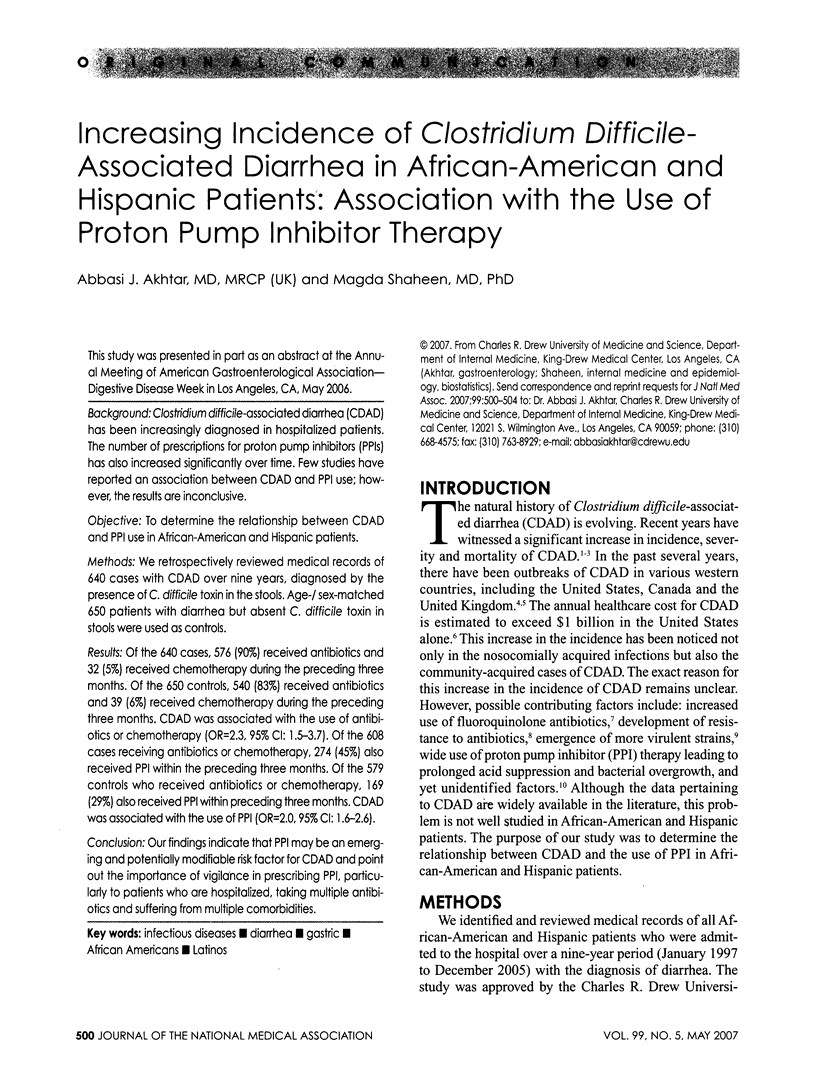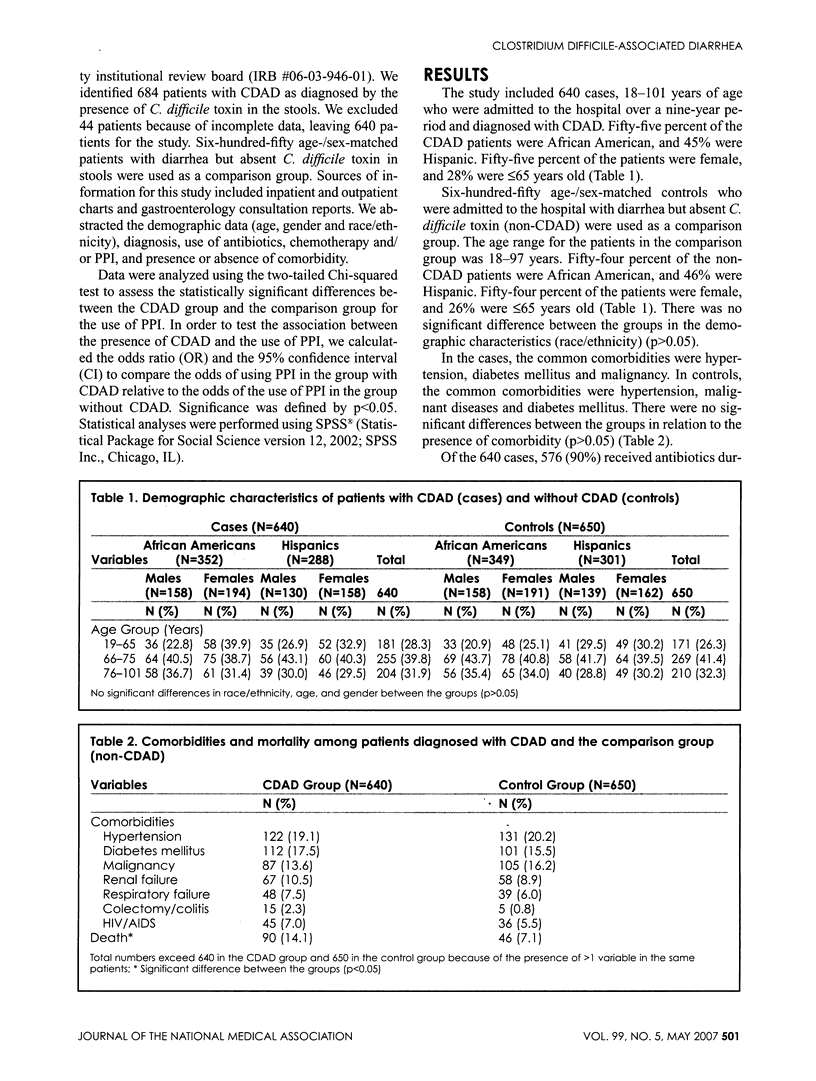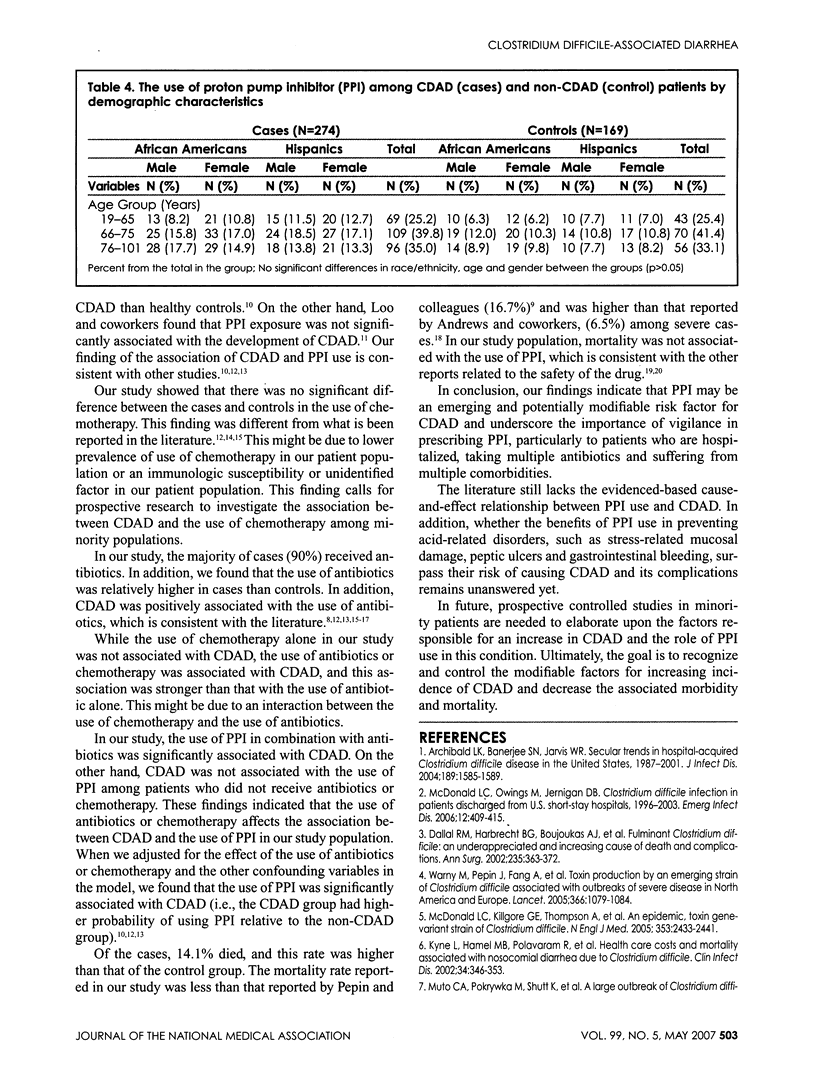Abstract
BACKGROUND: Clostridium difficile-associated diarrhea (CDAD) has been increasingly diagnosed in hospitalized patients. The number of prescriptions for proton pump inhibitors (PPIs) has also increased significantly over time. Few studies have reported an association between CDAD and PPI use; however, the results are inconclusive. OBJECTIVE: To determine the relationship between CDAD and PPI use in African-American and Hispanic patients. METHODS: We retrospectively reviewed medical records of 640 cases with CDAD over nine years, diagnosed by the presence of C. difficile toxin in the stools. Age-/ sex-matched 650 patients with diarrhea but absent C. difficile toxin in stools were used as controls. RESULTS: Of the 640 cases, 576 (90%) received antibiotics and 32 (5%) received chemotherapy during the preceding three months. Of the 650 controls, 540 (83%) received antibiotics and 39 (6%) received chemotherapy during the preceding three months. CDAD was associated with the use of antibiotics or chemotherapy (OR = 2.3, 95% CI: 1.5-3.7). Of the 608 cases receiving antibiotics or chemotherapy, 274 (45%) also received PPI within the preceding three months. Of the 579 controls who received antibiotics or chemotherapy, 169 (29%) also received PPI within preceding three months. CDAD was associated with the use of PPI (OR = 2.0, 95% CI: 1.6-2.6). CONCLUSION: Our findings indicate that PPI may be an emerging and potentially modifiable risk factor for CDAD and point out the importance of vigilance in prescribing PPI, particularly to patients who are hospitalized, taking multiple antibiotics and suffering from multiple comorbidities.
Full text
PDF




Selected References
These references are in PubMed. This may not be the complete list of references from this article.
- Archibald Lennox K., Banerjee Shailen N., Jarvis William R. Secular trends in hospital-acquired Clostridium difficile disease in the United States, 1987-2001. J Infect Dis. 2004 Apr 20;189(9):1585–1589. doi: 10.1086/383045. [DOI] [PubMed] [Google Scholar]
- Barbut F., Petit J. C. Epidemiology of Clostridium difficile-associated infections. Clin Microbiol Infect. 2001 Aug;7(8):405–410. doi: 10.1046/j.1198-743x.2001.00289.x. [DOI] [PubMed] [Google Scholar]
- Blot E., Escande M-C, Besson D., Barbut F., Granpeix C., Asselain B., Falcou M-C, Pouillart P. Outbreak of Clostridium difficile-related diarrhoea in an adult oncology unit: risk factors and microbiological characteristics. J Hosp Infect. 2003 Mar;53(3):187–192. doi: 10.1053/jhin.2002.1356. [DOI] [PubMed] [Google Scholar]
- Cunningham R., Dale B., Undy B., Gaunt N. Proton pump inhibitors as a risk factor for Clostridium difficile diarrhoea. J Hosp Infect. 2003 Jul;54(3):243–245. doi: 10.1016/s0195-6701(03)00088-4. [DOI] [PubMed] [Google Scholar]
- Dallal Ramsey M., Harbrecht Brian G., Boujoukas Arthur J., Sirio Carl A., Farkas Linda M., Lee Kenneth K., Simmons Richard L. Fulminant Clostridium difficile: an underappreciated and increasing cause of death and complications. Ann Surg. 2002 Mar;235(3):363–372. doi: 10.1097/00000658-200203000-00008. [DOI] [PMC free article] [PubMed] [Google Scholar]
- Dial Sandra, Alrasadi Khalid, Manoukian Chantal, Huang Allen, Menzies Dick. Risk of Clostridium difficile diarrhea among hospital inpatients prescribed proton pump inhibitors: cohort and case-control studies. CMAJ. 2004 Jul 6;171(1):33–38. doi: 10.1503/cmaj.1040876. [DOI] [PMC free article] [PubMed] [Google Scholar]
- Dial Sandra, Delaney J. A. C., Barkun Alan N., Suissa Samy. Use of gastric acid-suppressive agents and the risk of community-acquired Clostridium difficile-associated disease. JAMA. 2005 Dec 21;294(23):2989–2995. doi: 10.1001/jama.294.23.2989. [DOI] [PubMed] [Google Scholar]
- Kyne Lorraine, Hamel Mary Beth, Polavaram Rajashekhar, Kelly Ciarán P. Health care costs and mortality associated with nosocomial diarrhea due to Clostridium difficile. Clin Infect Dis. 2001 Dec 17;34(3):346–353. doi: 10.1086/338260. [DOI] [PubMed] [Google Scholar]
- Lamberts R., Brunner G., Solcia E. Effects of very long (up to 10 years) proton pump blockade on human gastric mucosa. Digestion. 2001;64(4):205–213. doi: 10.1159/000048863. [DOI] [PubMed] [Google Scholar]
- Loo Vivian G., Poirier Louise, Miller Mark A., Oughton Matthew, Libman Michael D., Michaud Sophie, Bourgault Anne-Marie, Nguyen Tuyen, Frenette Charles, Kelly Mirabelle. A predominantly clonal multi-institutional outbreak of Clostridium difficile-associated diarrhea with high morbidity and mortality. N Engl J Med. 2005 Dec 1;353(23):2442–2449. doi: 10.1056/NEJMoa051639. [DOI] [PubMed] [Google Scholar]
- Louie Thomas J., Meddings Jon. Clostridium difficile infection in hospitals: risk factors and responses. CMAJ. 2004 Jul 6;171(1):45–46. doi: 10.1503/cmaj.1040966. [DOI] [PMC free article] [PubMed] [Google Scholar]
- McDonald L. Clifford, Killgore George E., Thompson Angela, Owens Robert C., Jr, Kazakova Sophia V., Sambol Susan P., Johnson Stuart, Gerding Dale N. An epidemic, toxin gene-variant strain of Clostridium difficile. N Engl J Med. 2005 Dec 1;353(23):2433–2441. doi: 10.1056/NEJMoa051590. [DOI] [PubMed] [Google Scholar]
- McDonald L. Clifford, Owings Maria, Jernigan Daniel B. Clostridium difficile infection in patients discharged from US short-stay hospitals, 1996-2003. Emerg Infect Dis. 2006 Mar;12(3):409–415. doi: 10.3201/eid1203.051064. [DOI] [PMC free article] [PubMed] [Google Scholar]
- Pépin Jacques, Valiquette Louis, Cossette Benoit. Mortality attributable to nosocomial Clostridium difficile-associated disease during an epidemic caused by a hypervirulent strain in Quebec. CMAJ. 2005 Sep 22;173(9):1037–1042. doi: 10.1503/cmaj.050978. [DOI] [PMC free article] [PubMed] [Google Scholar]
- Vesta Kimi S., Wells Paula G., Gentry Chris A., Stipek Wanda J. Specific risk factors for Clostridium difficile-associated diarrhea: a prospective, multicenter, case control evaluation. Am J Infect Control. 2005 Oct;33(8):469–472. doi: 10.1016/j.ajic.2005.06.004. [DOI] [PubMed] [Google Scholar]
- Warny Michel, Pepin Jacques, Fang Aiqi, Killgore George, Thompson Angela, Brazier Jon, Frost Eric, McDonald L. Clifford. Toxin production by an emerging strain of Clostridium difficile associated with outbreaks of severe disease in North America and Europe. Lancet. 2005 Sep 24;366(9491):1079–1084. doi: 10.1016/S0140-6736(05)67420-X. [DOI] [PubMed] [Google Scholar]
- Wu Jun, Ge Xian, Fahy Gregory M. Ultrarapid nonsuture mated cuff technique for renal transplantation in rabbits. Microsurgery. 2003;23(4):369–373. doi: 10.1002/micr.10145. [DOI] [PubMed] [Google Scholar]


